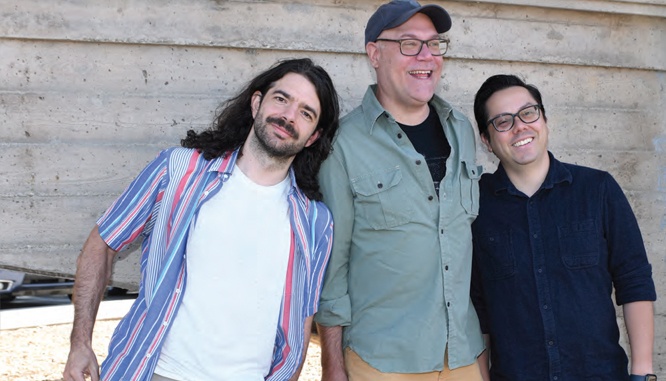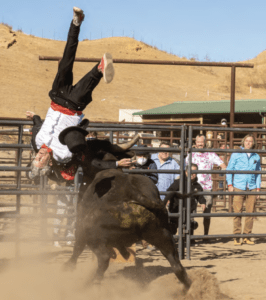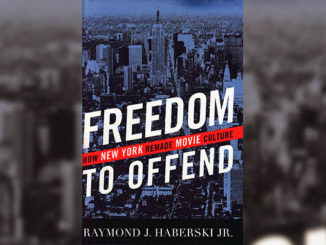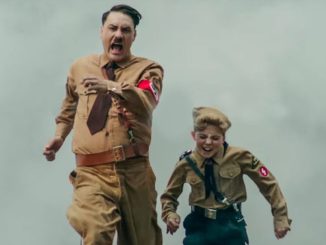
By Rob Feld
Highbrow or low, there is a reason why some movies capture an audience and others don’t. That “Jackass” has sustained a 20-year franchise of guys finding new and laborious ways to hit each other in the crotch—when audiences could easily find online clips to satisfy such a craving without looking up from their phones—must indicate that its creators discovered … something.
Editors Matt Kosinski, Matt Probst, and Sascha Stanton-Craven are the caretakers of that strange potion in the fourth installment of the series, “Jackass Forever.”
What began as an MTV series has since fostered assorted spinoffs and four movies directed by Jeff Tremaine and produced by Spike Jonze and Johnny Knoxville. In the show born of skateboard culture’s couldn’t-care-less attitude, a merry band of outcasts crack each other up by performing an endless string of transgressive, scatological, and self-damaging stunts. The more elaborate a silly gag can be, the better. For 20 years, audiences have followed the Jackass personalities Johnny Knoxville, Steve-O, Wee Man, Chris Pontius, and others, onscreen and off. “Jackass Forever” introduces a new and younger bunch, who join in the antics along with the legacy cast.
The challenge for Kosinski, Probst, and Stanton-Craven was to capture the same chemistry between the familiar cast that brought audience back time and again, while establishing and blending in the new members. Lose the chemistry, and the franchise dies and an audience might as well get its crotch-shot fix on YouTube.

CineMontage: Despite the success of the “Jackass” franchise, you guys were involved in cutting test shoots efore anyone would greenlight the movie, correct?
Sascha Stanton-Craven: Coming back after 10 years, I think a fear was, “Will it still be funny to see a 50-year-old man get wrecked, or just sort of sad?” Fortunately, the answer is “yes,” it is still funny to see that. Matt Kosinski: They also wanted to make sure that the chemistry between the cast was still there, and to test out the new cast. It turned out great, everything was clicking, everyone was having a good time. A lot of those bits ended up in the movie.
CineMontage: It’s interesting to remember how important their chemistry is—it’s not just about the gags. What is there to learn about investing an audience in characters from the “Jackass” series?
Matt Probst: Sometimes you can have a 30-second bit, but I think what really works for “Jackass” is to show the care and love that they have for each other; that it’s not just about hurting each other, it’s about the experience as a whole. The key is to include that as well as the pain. I think you see the bond that they have on screen, which has carried it from the series all the way through this fourth film.
Sascha Stanton-Craven: It feels like you’re a part of the hangout, that you’re there with them as they’re trying these things out, trying to one up each other, coming up with new stupider things to do. The stunt or prank is the centerpiece. But if that’s all it is, it feels airless. The more you feel their dynamic, messing with each other, the more life it has. That alchemy makes it work. And them not wanting to do it, pressuring each other to do it—all of that. It has to be genuine. And to your point about character, there are things which are like, “That’s so Steve-O.” Or Pontius is sort of the guy who wraps things up with funny quips. They’re themselves but know their roles in some way. So it’s bringing all those things out in a way that feels organic—which is easy, because it is.
CineMontage: With so much footage, how are you making decisions?
Matt Kosinski: There’s a million different ways you can take a bit, and Jeff [Tremaine] gives us a lot of leeway in our first cuts to interpret the footage before he, [Johnny] Knoxville and Spike [Jonze] come in. Not having a lot of guidance at the beginning keeps it fresh for me so I can have that sense of play before we start shaping it based on what the producers feel like the scene needs and what the movie needs—at certain point, these scenes need to work together and feel cohesive.
Matt Probst: You don’t want to see someone execute a perfect stunt in “Jackass.” What works best is when it doesn’t work. You need to show the process of the stunt, the different elements, and the fail. So part of it is telling that story within the bit itself. And we can always condense or expand on it because they’re always rolling.
CineMontage: Sascha, this was your first “Jackass” project. How did you get schooled in “Jackass”?
Sascha Stanton-Craven: There is a thought-out aesthetic to the entire thing. I learned you need to preserve the feeling of it happening in real time. That’s much more effective and compelling than trying to get in as many great bits as possible. That component of being part of the hangout was a revelation I had halfway through. Your first pass at a bit is, fundamentally, is this going to be funny or not? Is there something here? Once you have the bit, then it’s, what’s the right way to play it? There were bits that felt airless at first: setup, stunt, we’re done. With those, it was about roughing them up, opening them up.
One example is the testicle speed bag bit with the boxing gloves. Initially it was just that: you see the model set, the gloves go in and punch the testicles. Then you pull out, you see Preston there in pain, and that’s it. It was a great visual but it felt like, is that the whole thing? So, we went back in, thought, They did do multiple takes of this. Why don’t we have that be part of the narrative of this bit? So we put in Jeff saying, “We got to go again,” Preston having to ramp himself up with Knoxville just thinking it’s the funniest thing in the world. They definitely got the shot the first time, so seeing Jeff wanting to do it again, just to do it again, became the emotional architecture of the bit. And that’s “the hangout” right there.
CineMontage: It’s the character element that separates “Jackass” from “America’s Funniest Home Videos.”
Matt Probst: Absolutely. That’s what gives it its longevity. “Jackass” is about the two minutes before the stunt, and the two minutes after, and the two minutes within. It’s not about the stunt. It’s about the people doing the stunts. We’re in the world of competing with YouTube and TikTok and any viral video, too. But you want to follow these same guys for 20 years because you have gotten to know them and they have personalities.
Matt Kosinski: The Triple Wedgie bit could have been cut with the two guys jumping down, Wee Man gets the wedgie and we’re out. But what makes it work is seeing them joke about the grimy mattresses that everyone has to land on and speculating, “Where did we even get this, the garbage dump?” And Knoxville asking Zach if he’s afraid of heights and Zach saying he’s terrified of heights. It’s all the texture and detail you’re not getting in “America’s Funniest Home Videos.”
Matt Probst: There’s always a peanut gallery on set. If someone’s not in the bit, they’re in the bit because they’re there watching, laughing along with the audience at home. We create the atmosphere by the guys being there and watching their friends going through it together.
Sascha Stanton-Craven: They’re a tribe and, if we do our jobs right, you feel like you are in the group, having a fun time with them. They’re also all professional showmen. They understand how to elevate something to get what is elemental or fundamentally fun or stupid or silly about it. Knoxville makes the best ringleader because he is so good at drawing that out of other people, at being the narrator for the entire thing, where he’s both in the thing, but also giving perspective to it. It’s really elegant. It’s his natural instincts. He almost has an editor’s perspective.
CineMontage: Why are we so willing to watch people get hit in the crotch over and over and over … and over?
Matt Kosinski: It’s primal and we’re tapping into that. You can show “Jackass” to a caveman, and the caveman will laugh about it. But as we’ve talked about, it’s making sure that we’re adding these character details and that the audience is invested in these guys. You do care more about watching these guys get hit in the nuts for some reason, rather than the random YouTube guy. It’s the friendship that makes that work. They’re doing it to each other and they’re laughing and that’s part of the magic. But it is nut hits, farts … These are all timelessly funny.
Sascha Stanton-Craven: And there’s a celebration of how stupid it is and how much work is being put into it. That is part of the joy.
CineMontage: Not to intellectualize “Jackass,” but I mean, what is it? It feels like an attitude to me.
Matt Probst: It’s a little punk rock. I think there’s a chaos about it that comes out of the screen. They’re rebelling. You’re just not exactly sure what they’re rebelling about.
Matt Kosinski: Maybe the attitude comes through the unique mix of influences that go into “Jackass.” There’s the punk rock element. There’s skateboard culture, there’s extreme sports culture. Knoxville brings this outlaw-country flavor. And of course “Looney Tunes” is a huge part of it. The legacy guys always bring so much to the table, and this time around the producers did a great job of bringing in the new cast and making sure that they blended in, while bringing their own style into the mix.
Sascha Stanton-Craven: When the show started, with skate culture suddenly getting an expression on MTV, it was a sub-version of masculinity as it was understood at that point—the way that they show their bodies and mess with their bodies, even down to Pontius’ Bunny the Lifeguard. There’s a lack of caring about those norms or rules that is a big part of the attitude. As culture has moved, I think the way that they have maintained relevance is by not posturing.
Sascha Stanton-Craven: It worked for them in the beginning because it is genuinely who they are. And they are still those guys. You can’t hide who you are when you’re terrified for your nuts. C
CineMontage: From how many cameras are you generally getting footage?
Matt Kosinski: It could go from five cameras to 15. In hidden camera bits, they’ll put GoPros all around the room to make sure that we’re well covered. And then there’s a bunch of camera guys and hides. Even a normal bit, you’re going to have two or three main cameras, maybe a behind the scenes camera getting more intimate shots. Then a couple of cameras just getting slow-mo, which you can speed up and use as a main camera if you have to. You do need to be ruthless with cutting the footage because you’re going to leave a lot of great stuff out and a lot of great angles out. You need to cut it in the way that’s going to maximize how funny the scene is and keep the momentum going. You’re not going to be able to use 95% of the footage. For the hidden camera bits we did, I think Probst and I had some leftover instincts from cutting “Bad Grandpa,” which competed with our style here because “Bad Grandpa” had a story. It felt satisfying to live in those pranks for a long time, get to know the marks, and follow up on their reactions after the prank. So, our first cuts for a lot of the hidden camera pranks in “Jackass Forever” reflected that style initially. When we watched it as its own scene, it was really funny to explore what the marks were saying after the fact, and Irving having funny conversations with them. But when you put it in the movie, where everything else happens at a break-neck pace, it was funny, but didn’t work for the style.
Matt Probst: Another important element of “Jackass” is the flow of the movie. A lot of thought is put behind the order of when we see things. You find the balance of how everything flows together, where you need to put the big laughs and quieter moments. It’s a roller coaster and you need that mood the entire time, but you don’t just do loopy loops; you’ve got to go up high, and then you go for the big drop, and then you do the loop, and then you go into the tunnel. It’s a ride but has to be well crafted; otherwise, you’re going to lose people or exhaust them. There’s a reason why people keep coming back to it because of this flow.
Matt Kosinski: You do get into funny conversations because you might be like, “We’ve got to spread out the penis bits a little bit more evenly so people don’t get exhausted.” You don’t want too many gross-out gags next to each other, and you don’t want too many things where people get seriously injured next to each other. And you want to make sure you are trying to create a balance for the cast. You don’t want to go too long without seeing Steve-O pop up and you don’t want to lose track of what Jasper’s thinking.
Matt Kosinski: We do have a big board in the office with stickers like, a pink sticker means a gross gag, a green sticker means a music-driven gag, or a red sticker, a penis gag. So, we can see the layout of the movie and start moving cards around and getting it working on paper. Then we go back and refresh the sequencing within the film.
Sascha Stanton-Craven: The complex formula of short, gnarly bit with a dick without Steve-O, versus long bit with Steve-O. It’s a beautiful mind map.






